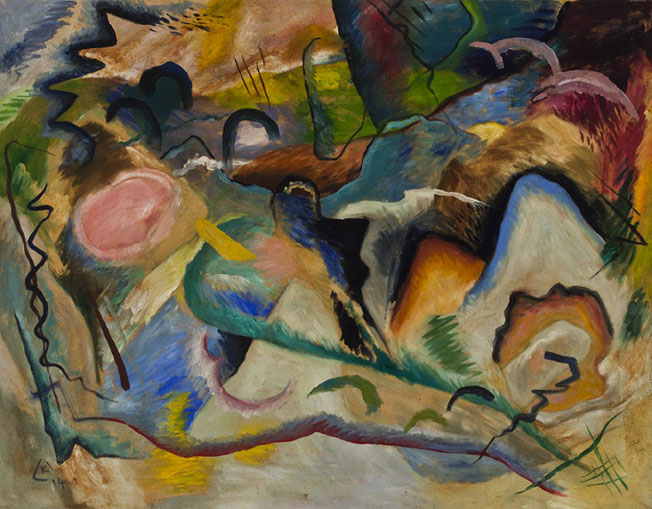Expressionist Impulses: German and Central European Art, 1890–1990
October 1, 2015–January 10, 2016

Attributed to Wassily Kandinsky, Composition, 1914, Oil on canvas. Smart Museum of Art, The University of Chicago, Gift of Dolores and Donn Shapiro in honor of Jory Shapiro, 2012.51.
In the years before World War I, Expressionism was a term vanguard art circles in France, Germany, and Central Europe used to denote various modern art movements that arose after Impressionism.
Whether figurative or abstract, pre-war Expressionism was foremost anti-naturalist in style and idealist in content. Utilizing simplified forms, distorted details, and unnatural colors, Expressionist artists sought to penetrate to the essence of outer appearances to elicit an emotional response from the viewer. For such artists, exaggeration expressed their inner responses to the visual world around them, whether in the service of utopian idealism or to rebut contemporary social mores and injustices.
Spanning a century of momentous and rapid political, social, and economic change, this exhibition charts the ebb and flow of key Expressionist tendencies in German and Central European art from, among other countries, Czechoslovakia, Poland, and Romania.
The incisive, often emotionally charged paintings, drawings, and sculptures on view—mounted from the Smart’s collection and supplemented by select promised gifts—bear powerful witness to periods of war, utopian dreams, economic depression, political division, and personal and political exile. No single style, technique, or theme dominates. Rather, Expressionist Impulses offers a fluid account of multiple waves of artists who were concerned with stylistic innovation bent in the service of social and political critiques.
The exhibition includes approximately 80 works and is divided into loosely chronological sections that cover major Expressionist moments in Germany: Die Brücke (1905–1914), Der Blaue Reiter (1911–1914), New Objectivity (1920s), and Neo-Expressionism (1960–80s). It also brings to the surface often overlooked international connections to modernism and the expressive impulse in avant-garde artists active across the great art centers of Germany and the Austro-Hungarian Empire before the rupture of The Great War and in a divided Germany and Communist Europe throughout the Cold War.
Artists
Josef Albers, Georg Baselitz, Lovis Corinth, Max Dungert, Lyonel Feininger, Emil Filla, George Grosz, Erich Heckel, Hans Hofmann, Jörg Immendorff, Wassily Kandinsky, Martin Kippenberger, Ernst Ludwig Kirchner, Käthe Kollwitz, Karel Malich, Jan Matulka, Ludwig Meidner, Gabriele Münter, Richard Oelze, Emil Nolde, Felix Nussbaum, Max Pechstein, Karl Peter Röhl, and Kurt Schwitters, among others.
This hybrid hash, this metaphysical meatloaf called Expressionism, was hacked out of the flesh of Cubism and Futurism”
—Hans Arp and El Lissitsky, Die Kunstismen, 1925










